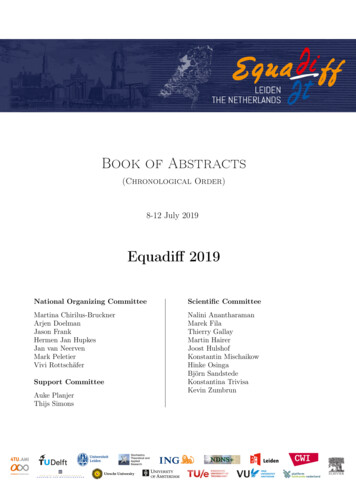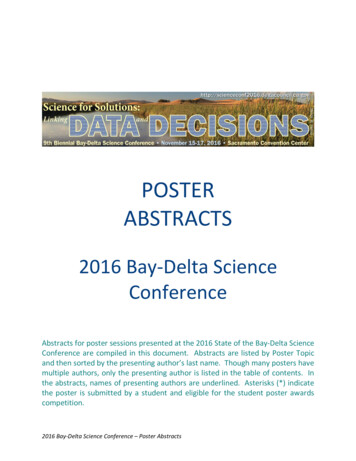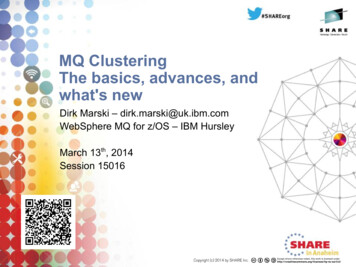
Transcription
Book of Abstracts(Chronological Order)8-12 July 2019Equadiff 2019National Organizing CommitteeScientific CommitteeMartina Chirilus-BrucknerArjen DoelmanJason FrankHermen Jan HupkesJan van NeervenMark PeletierVivi RottschäferNalini AnantharamanMarek FilaThierry GallayMartin HairerJoost HulshofKonstantin MischaikowHinke OsingaBjörn SandstedeKonstantina TrivisaKevin ZumbrunSupport CommitteeAuke PlanjerThijs Simons
Monday July 8thPlenary Talk 1 - 10:00-11:00Gluing methods for Vortex dynamics in Euler flowsManuel del Pino (University of Bath)Mon 08 Jul10:00PlenaryHKWe consider the two-dimensional Euler flow for an incompressible fluid confined to a smooth domain.We construct smooth solutions with concentrated vorticities around points which evolve according to theHamiltonian system for the Kirkhoff-Routh energy. The profile around each point resembles a scaled finitemass solution of Liouville’s equation. We discuss extensions of this analysis to the case of vortex filamentsin 3-dimensional space, along the lines of Da Rios 1904 vortex filament conjecture in connection with thebinormal flow of curves.Plenary Talk 2 - 11:30-12:30Design of large scale optimization algorithms from stochastic non-smoothdynamics perspectivesRachel Kuske (Georgia Tech)Co-authors: Emmanouil Daskalakis (UBC), Felix Herrmann (Georgia Tech)Computations in machine learning, inverse problems, data fitting, and approximations rely heavily onoptimization algorithms with stochastic and non-smooth features. Dynamical systems perspectives are increasingly important for algorithm design and performance. We highlight a combination of perspectives fromstochastic nonlinear dynamics, control systems, and coherence resonance points that provide insight for algorithm improvement motivated by real world limitations. The theoretical requirements for convergence arenot necessarily met In the realistic setting where the problem is large scale, overdetermined and inconsistent. Then the algorithms face challenges analogous to the chattering phenomena in non-smooth controlproblems. Viewing iterations of the algorithm as coupled systems of equations for large and small entries,we identify an efficient modified dynamic algorithm that removes the chatter and drives faster convergence,particularly for noisy, large scale, compressible problems which require sub-sampling and a limited numberof data passes. The dynamical systems perspective also points to value for streaming (online) applications,automatic optimization of thresholds, and connections to other dynamical systems perspectives in seekingoptimal search directions.1Mon 08 Jul11:30PlenaryHK
Parallel Sessions 1 - 14:00-16:00MS1 Part 1 of 2 - Computer-Assisted Proofs in DynamicsComputer-assisted existence and multiplicity proofs for semilinear ellipticboundary value problemsMichael Plum (Karlsruhe Institute of Technology (KIT))Mon 08 Jul14:00MS1KO-4For semilinear elliptic boundary value problems on bounded or unbounded domains, a general computerassisted method for proving the existence of a solution in a “close” and explicit neighborhood of an approximate solution, computed by numerical means, is proposed. To achieve such an existence and enclosureresult, we apply Banach’s fixed-point theorem to an equivalent problem for the error, i.e., the difference between exact and approximate solution. The verification of the conditions posed for the fixed-point argumentrequires various analytical and numerical techniques, in particular the computation of eigenvalue bounds forthe linearization at the approximate solution. The method is used to prove existence and multiplicity resultsfor various specific examples where purely analytical methods had not been successful.The parameterization method, transverse intersections, and computer assistedproof in celestial mechanicsJason Mireles James (Florida Atlantic University)Mon 08 Jul14:30MS1KO-4I will discuss strategies for combining the parameterization method for invariant objects with tools fromvalidated numerics and functional analysis to solve some problems in celestial mechanics.Sofic shifts via Conley index theory: computing lower bounds on recurrentdynamics for mapsSarah Day (William & Mary)Co-authors: Rafael Frongillo (University of Colorado, Boulder)Mon 08 Jul15:00MS1KO-4Recent work has demonstrated the effectiveness of computational Conley index techniques in extractingdynamics from discrete-time systems governed by maps. I will discuss an automated approach that builds onearlier work and uses Conley index information to construct sofic shifts that are topologically semi-conjugateto the system under study. This allows for the uncovering and recording of increasingly complicated dynamicsin chaotic systems. As illustration, we present results for the two-dimensional Henon map and the infinitedimensional Kot-Schaffer map.Rigorous numerics for nonlinear heat equations in the complex plane of timeAkitoshi Takayasu (University of Tsukuba)Co-authors: Jean-Philippe Lessard (McGill University), Hisashi Okamoto (Gakushuin University)In this talk, we consider a numerical method for proving the existence of solutions for nonlinear heatequations in the complex t-plane. Extending the time variable of nonlinear heat equations into the complexplane, there seem to be no singularity other than the blow-up point, which exists on the real line. Our aimof this study is to turn out the dynamics of such a solution with computer assistance. As a first step of thisstudy, we provide a rigorous integrator of the complex-valued nonlinear heat equations (a kind of complexGinzburg-Landau equation) using Chebyshev-Fourier spectral methods.2Mon 08 Jul15:30MS1KO-4
MS3 Part 1 of 2 - Space-time techniques for the numerical solution of PDEsCoercive space-time finite element methodsOlaf Steinbach (TU Graz)Co-authors: Marco Zank (TU Graz)Mon 08 Jul14:00MS3KO-5We propose and analyze new space-time Galerkin-Bubnov type finite element formulations of parabolicand hyperbolic second order partial differential equations in finite time intervals. This approach is based,using Hilbert type transformations, on elliptic reformulations of first and second order time derivatives, forwhich the Galerkin finite element discretization results in positive definite and symmetric matrices. Forthe variational formulation of the heat and of the wave equation we prove related stability conditions inappropriate norms, and we discuss the stability of related finite element discretizations. Numerical resultsare given which confirm the theoretical results.A Space-Time Approach to Two-Phase Stokes FlowIgor Voulis (Johannes Gutenberg-Universität Mainz)Mon 08 Jul14:30MS3KO-5We consider a time dependent Stokes problem with a prescribed, sharp, moving interface. This modelproblem has discontinuous density and viscosity coefficients, a pressure solution that is discontinuous acrossan evolving interface and an interfacial force (surface tension). This strongly simplified model problem isused to develop and analyse of space-time finite element discretization methods for two-phase flow problems.For this Stokes problem a dynamic spatial mesh is considered because it is a useful tool to limit thecomputational cost for two-phase flow problems where a fine mesh is only necessary near the moving interface.We discuss the influence of the changing spatial mesh on the global error bounds. This is done for the velocityand for the pressure Lagrange multiplier. We also consider the influence of a (discrete) temporal derivativewith a discontinuous time-dependent coefficient.Time-parallel iterative solvers for parabolic evolution equationsIain Smears (University College London)Co-authors: Martin Neumuller (Johannes Kepler University Linz)Mon 08 Jul15:00MS3KO-5Time-parallel solvers are iterative methods for the discrete systems originating from evolution problems,and they can provide effective alternatives to the sequential time-stepping approach on parallel computers.Although time-parallel methods can applied to classical time-discretisation schemes, they are based on aglobal space-time formulation of the problem that is similar to the approach adopted in recent space-timediscretisation methods. We present how the inf-sup stability of space-time formulations of continuous anddiscretized parabolic problems provides an effective approach to the construction and rigorous analysis ofparallel-in-time solvers. Considering the implicit Euler discretization of a general linear parabolic evolutionequation with time-dependent self-adjoint spatial operators, we use the inf-sup stability of the problem toshow that the standard nonsymmetric time-global system can be equivalently reformulated as an originalsymmetric saddle-point system that remains inf-sup stable in the same norms. We then propose and analysean inexact Uzawa method for the saddle-point reformulation based on an efficient parallel-in-time preconditioner. The preconditioner is non-intrusive and easy to implement in practice, and we prove robust spectralbounds, leading to convergence rates that are independent of the number of time-steps, final time, or spatialmesh sizes. Large scale parallel numerical experiments demonstrate the efficiency of the method.Stability of Galerkin discretizations of parabolic evolution equationsRob Stevenson (University of Amsterdam)Co-authors: Jan Westerdiep (University of Amsterdam)We analyze Galerkin discretizations of a new well-posed mixed space-time variational formulation ofparabolic PDEs. For suitable pairs of finite element trial spaces, the resulting Galerkin operators are shownto be uniformly stable. The method is compared to two related space-time discretization methods introducedin [IMA J. Numer. Anal., 33(1) (2013), pp. 242-260] by R. Andreev and in [Comput. Methods Appl. Math.,15(4) (2015), pp. 551-566] by O. Steinbach.3Mon 08 Jul15:30MS3KO-5
MS4 Part 1 of 1 - Dynamics on and of networksDynamical distribution networksArjan van der Schaft (University of Groningen)Mon 08 Jul14:00MS4KO-6Distribution networks arise abundantly, in the natural as well as in the engineering sciences. In manycases they are inherently dynamical, e.g., due to internal storage. On the other hand, they differ fromstandard dynamical systems in at least two aspects: 1) distribution networks are typically open systemswith non-zero inflows and outflows, 2) their complexity is primarily caused by their large-scale nature;similar to network flow theory in optimization. In this talk we aim at a general geometric framework forthe modeling, analysis and control of dynamical distribution networks, based on port-Hamiltonian systemstheory. We will primarily discuss two main examples: power networks as underlying the electricity grid, andchemical reaction networks as appearing in systems biology. One specific question to be addressed concernsthe stability of dynamical distribution networks for constant, but non-zero, in-out flows, corresponding tosteady states that are not anymore minima of the storage functions (Hamiltonians). Furthermore, in thecontext of power networks we will address the stability of the physical dynamics coupled to market dynamics,as arising from the adjustment of the generated and consumed power towards optimal steady state valuesset by static optimization.The Kuramoto model with compact bimodal frequency distributions andfirst-order phase transitionsAndreas Daffertshofer (Vrije Universiteit Amsterdam)Co-authors: Bastian Pietras (TU Berlin), Nicolás Deschle (Vrije Universiteit Amsterdam)Mon 08 Jul14:30MS4KO-6Complex oscillatory networks can exhibit first-order phase transitions when the distribution of the natural frequencies over nodes has a finite flat region at its maximum. First-order phase transitions includinghysteresis and bistability are also present if the frequency distribution of a single network is bimodal. Theinterplay between these two configurations will be discussed by analysing the Kuramoto model of phaseoscillators with compact bimodal frequency distributions in the continuum limit. The full bifurcation diagram for the system’s order parameter dynamics can be derived by combining Kuramoto’s self-consistencyapproach, Crawford’s symmetry considerations, and the Ott-Antonsen ansatz applied to a family of rationaldistribution functions that converge towards the compact distribution. As will be shown, the route to synchronization always passes through a standing wave regime when the bimodal distribution is compoundedby two unimodal distributions with compact support. This is in contrast to a possible transition across aregion of bistability when the two compounding unimodal distributions have infinite support.Synchronization in feed-forward networksAna Dias (University of Porto)Co-authors: Manuela Aguiar (University of Porto), Flora Ferreira (Porto), Michael Field (Rice University, Houston)Mon 08 Jul15:00MS4KO-6Patterns of synchrony of weighed networks can be described in a similar way as in the coupled cell networksformalism of Golubitsky, Stewart and collaborators. In this talk, we characterize the synchrony patternsof feed-forward networks, and we show how the addition of feedback loops to a feed-forward network canenrich the synchrony structure. One of the results, for identical cell networks with additive input structureand feedback from the final to the initial layer of the network, shows that periodic synchrony patterns canoccur.Asynchronous phase oscillator networksChristian Bick (University of Exeter)We will discuss some recent results on the network dynamics of oscillator networks which can decouplefor some time as the dynamics evolve. Such dynamics arise are relevant for example for networks of neuronaloscillators with refractory periods and adaptive couplings. They also relate to the recently introducedframework of "asynchronous networks."4Mon 08 Jul15:30MS4KO-6
MS8 Part 1 of 3 - Geometric Singular Perturbation Theory and ApplicationsDiscretized fast-slow systems near singularitiesMaximilian Engel (TU Munich)Co-authors: Christian Kuehn (TU Munich), Luca Arcidiacono (TU Munich), Matteo Petrera (TU Berlin), YuriSuris (TU Berlin)Mon 08 Jul14:00MS8KO-7We show how to extend slow manifolds near various kinds of singularities in fast-slow systems given bytime discretizations of the corresponding continuous-time normal form. The analysis applies the blow-upmethod, which has so far mainly been used for flows, to fast-slow dynamical systems induced by maps anduses direct trajectory-based estimates.For transcritical and pitchfork singularities, we prove that the qualitative behaviour is preserved by anytime-discretization, where the step size is fully quantified relative to the time scale separation.For canard points at folds, we demonstrate that, due to a formal conserved quantity, the Kahan discretization and related symplectic methods preserve canard solutions for relatively large step sizes and longtimes as opposed to, for example, the Euler method.Gevrey asymptotic properties of slow manifoldsKarel Kenens (Hasselt University)Co-authors: Peter De Maesschalck (Hasselt University)Mon 08 Jul14:30MS8KO-7In geometric singular perturbation theory, Fenichel manifolds are typically only finitely smooth. Betterlocal smoothness properties can be achieved in an analytic setting. Under the condition that no singularitiesin the slow flow are present, there exist manifolds allowing a Gevrey-1 asymptotic expansion. When theslow flow does have a singularity, there are cases, including when the singularity is a node or focus, whereFenichel manifolds can be found being 1-summable in a certain direction.From noise-sustained structures to nonlinear absolute instabilityEdgar Knobloch (University of California at Berkeley)Mon 08 Jul15:00MS8KO-7A subcritical pattern-forming system with nonlinear advection in a bounded domain is recast as a slowfast system in space and studied using a combination of geometric singular perturbation theory and numericalcontinuation. Two types of solutions describing the possible location of stationary fronts are identified, whoseorigin is traced to the onset of convective and absolute instability when the system is unbounded. Theformer are present only for nonzero upstream boundary conditions and provide a quantitative understandingof noise-sustained structures in systems of this type. The latter correspond to the onset of a global mode andare present even with zero upstream boundary condition. The role of canard trajectories in the nonlineartransition between these states is clarified and the stability properties of the resulting spatial structures aredetermined. Front location in the convective regime is highly sensitive to the upstream boundary conditionand its dependence on this boundary condition is studied using a combination of numerical continuation andMonte Carlo simulations of the partial differential equation. Statistical properties of the system subjectedto random or stochastic boundary conditions at the inlet are interpreted using the deterministic slow-fastspatial-dynamical system. This is joint work with D Avitabile, M Desroches and M Krupa.Slow-fast systems in cell biology: new challenges for GSPTIlona Kosiuk (TU Wien)Systems with discontinuous vector fields arise in biological and engineering applications. GSPT has beenapplied to singularly perturbed problems obtained by smoothing of given discontinuous vector fields acrosssurfaces of discontinuity.In this talk I will discuss the application of GSPT to systems, which are smooth for ε 0, but limit ontonon-smooth variants, when ε 0. Hence, extra difficulties arise in the analysis of ε 0 limit as Fenicheltheory is not applicable in some regions of the phase space.This challenge is caused by the occurrence of small parameters in Michaelis-Menten type- and Hill terms,which are commonly found in ODE systems arising in cell biology.5Mon 08 Jul15:30MS8KO-7
MS10 Part 1 of 2 - Modulation equationsNonlocal PDE and Modulation EquationsChristian Kuehn (Technical University of Munich)Mon 08 Jul14:00MS10KO-8Nonlocal equations have recently appeared in a wide variety of contexts in the theory of differentialequations and we shall explain several surprising situations, where they appear. Then we consider modulationequations arising from a variety of PDE models involving convolution kernels. We are going to show how toprove approximation of the original PDE for the quadratic and cubic nonlinear cases.Validity of the Nonlinear Schrödinger Approximation for the Two-DimensionalWater Wave Problem With and Without Surface TensionWolf-Patrick Düll (Universität Stuttgart)Mon 08 Jul14:30MS10KO-8We consider the two-dimensional water wave problem in an infinitely long canal of finite depth bothwith and without surface tension. In order to describe the evolution of the envelopes of small oscillatingwave packet-like solutions to this problem the Nonlinear Schrödinger equation can be derived as a formalapproximation equation. In recent years, the validity of this approximation has been proven by severalauthors only for the case without surface tension. In this talk, we present the rigorous justification of theNonlinear Schrödinger approximation for the cases with and without surface tension by error estimates overa physically relevant timespan in the arc length formulation of the two-dimensional water wave problem.The error estimates are uniform with respect to the strength of the surface tension, as the height of the wavepacket and the surface tension go to zero.Global Well-Posedness and Higher Sobolev Bounds for Non-Focusing NLSEquations on Mixed DomainsNathan Totz (University of Miami)Mon 08 Jul15:00MS10KO-8We consider the long time well-posedness of the Cauchy problem with large initial data for a class ofnonlinear Schrodinger equations (NLS) on mixed flat/periodic domains of spatial dimension d 2, and withpower nonlinearities of arbitrary odd degree. This class of equations includes a family of energy supercriticaldefocusing NLS equations, as well as NLS equations of mixed spatial signature; global existence for suchequations by standard dispersive PDE methods is an open problem. We argue by contradiction that, ifcertain scaling-subcritical Sobolev norms of a solution increase faster than a certain threshold of growth, wecan directly construct arbitrarily close perturbations of this solution that grow slower than this growth rate,violating classical stability results. The perturbed NLS solution at the core of the argument is constructedas a modulational limit of a carefully constructed artificial evolution equation.Entirely Out of Character? Dispersive Dynamics in the Moving FrameDaniel Ratliff (Loughborough University)The Whitham modulation equations (WMEs) are a set of first order quasilinear PDEs governing thesecondary dynamics of wavetrains. These are dispersionless, and it has been a long-standing problem as tohow such features are incorporated. However, it will be shown that whenever the WMEs are hyperbolic,dispersion is always hidden within them - one simply waits long enough and moves with a speed of one ofits characteristics. This takes the form of the Korteweg-de Vries equation, whose coefficients are universalin the sense that these are tied solely to abstract properties of the Lagrangian density.A secondary tale then emerges: can properties of the characteristic suggest a different set of dynamics?The answer turns out to be yes, and this talk will highlight such features and the nonlinear dispersivedynamics which are associated to these. In particular, we identify properties which lead to the two-wayBoussinesq and Gardner equations emerging instead.6Mon 08 Jul15:30MS10KO-8
MS16 Part 1 of 2 - Qualitative theory of differential equationsAsymptotic analysis of regularly varying solutions of half-linear differentialequationsJelena Manojlovic (University of Nis, Faculty of Science and Mathematics)Co-authors: Takasi Kusano (Hiroshima University, Department of Mathematics, Faculty of Science)Mon 08 Jul14:00MS16KO-9We present results on the asymptotic behavior of eventually positive solutions of half-linear differentialequation(p(t) x0 α sgn x0 )0 q(t) x α sgn x 0 ,with q be continuous functions which may take both positive and negative values in any neighborhood ofinfinity and p be positive continuous functions satisfying one of conditionsZ Z dsds or .1/α1/αp(s)p(s)aaWith the help of Karamata theory of regular variation, asymptotic formulas for generalized regularly varyingsolutions will be established.Mutlichromatic Travelling Waves for Lattice Nagumo Reaction DiffusionEquationPetr Stehlik (University of West Bohemia)Co-authors: Hermen Jan Hupkes (Universiteit Leiden), Leonardo Morelli (Universiteit Leiden), Vladimir Svigler(University of West Bohemia)Mon 08 Jul14:30MS16KO-9In this talk we discuss multichromatic front solutions to the bistable Nagumo lattice differential equation.Such fronts connect the stable spatially homogeneous equilibria with spatially heterogeneous n-periodicequilibria and hence are not monotonic like the standard monochromatic fronts. These multichromaticfronts can disappear and reappear as the diffusion coefficient is increased. In addition, these multichromaticwaves can travel in parameter regimes where the monochromatic fronts are also free to travel. This leads tointricate collision processes where an incoming multichromatic wave can reverse its direction and turn intoa monochromatic wave.Nonlocal solutions of parabolic equationsLuisa Malaguti (University of Modena and Reggio Emilia)Co-authors: Irene Benedetti (University of Perugia), Valentina Taddei (Univesity of Modena and Reggio Emilia)Mon 08 Jul15:00MS16KO-9The paper deals with second order parabolic equations on bounded domains with Dirichlet conditionsin arbitrary Euclidean spaces. Their interest comes from being models for describing reaction–diffusionprocesses in several frameworks. A linear diffusion term in divergence form is included which generates astrongly elliptic differential operator. A further linear part, of integral type, is present which accounts ofnonlocal diffusion behaviours. The main result provides a unifying method for studying the existence andlocalization of solutions satisfying nonlocal associated boundary conditions. The Cauchy multipoint and themean value conditions are included in this investigation. The problem is transformed into its abstract settingand the proofs are based on the homotopic invariance of the Leray–Schauder topological degree. A boundingfunction (i.e. Lyapunov-like function) theory is developed, which is new in this infinite dimensional context.It allows that the associated vector fields have no fixed points on the boundary of their domains and then itmakes possible the use of a degree argument.Ground state solutions to nonlinear equations with p-LaplacianZuzana Došlá (Masaryk University)Co-authors: Serena Matucci (University of Florence)The existence of positive radial solutions is investigated for a nonlinear elliptic equation with p-Laplaceoperator and sign-changing weight, both in superlinear and sublinear case. We prove the existence of solutionswhich are globally defined and positive outside of a ball and tend to zero at infinity.7Mon 08 Jul15:30MS16KO-9
MS32 Part 1 of 2 - Degenerate diffusion processes and their controlHypocoercive diffusionsFabrice Baudoin (University of Connecticut)Mon 08 Jul14:00MS32KO-10We will review some of the methods developed in the last few years to prove convergence to equilibriumfor degenerate diffusion processes.Random walk approximations to sub-Riemannian diffusionsRobert Neel (Lehigh University)Mon 08 Jul14:30MS32KO-10We study a variety of geometrically-motivated random walks on sub-Riemannian manifolds and theirdiffusion limits under parabolic scaling, which give, via their infinitesimal generators, second-order operatorson the manifolds. A primary motivation is the lack of a canonical sub-Laplacian in sub-Riemannian geometry,and thus we are particularly interested in the relationship between the infinitesimal generators, the geodesicstructure, and operators which can be obtained as divergences with respect to various choices of volume.This talk is based on joint work with Ugo Boscain, Luca Rizzi, and Andrei Agrachev.Small-time fluctuations for conditioned hypoelliptic diffusionsKaren Habermann (Hausdorff Center for Mathematics, University of Bonn)Mon 08 Jul15:00MS32KO-10We study the small-time asymptotics for hypoelliptic diffusion processes conditioned by their initial andfinal positions. After giving an overview of work on small-time asymptotics for sub-Riemannian diffusionbridges, we present recent results on small-time fluctuations for the bridge in a model class of diffusionssatisfying a weak Hörmander condition, where the diffusivity is constant and the drift is linear. We showthat, while the diffusion bridge can exhibit a blow-up behaviour in the small time limit, we can still makesense of suitably rescaled fluctuations which converge weakly. We close by presenting work in progressregarding the point-to-subspace setting.Hardy inequalities in the Heisenberg groupValentina Franceschi (FMJH & IMO, Université Paris Sud)Co-authors: Dario Prandi (CNRS & L2S, CentraleSupélec )We present recent results about Hardy inequalities in the n-th Heisenberg group. In particular, we showthat, contrary to the Euclidean case, a radial Hardy inequality, i.e., a Hardy inequality taking into accountonly the directional derivative w.r.t. the sub-Riemannian distance, does not hold in this context for anydimension. Motivated by this fact, we then suggest the study of a non-radial Hardy inequality, based onthe construction of specific coordinates following from the explicit synthesis of sub-Riemannian geodesics.We prove a sharp weighted non-radial inequality that imply (non-sharp) bounds for the non-radial Hardyconstant on homogeneous cones. We underly through the latter a strong difference with respect to theEuclidean case.8Mon 08 Jul15:30MS32KO-10
MS34 Part 1 of 3 - Hamilton-Jacobi and ProbabilityMin-max representations of viscosity solutions of Hamilton-Jacobi equationsPierre Nyquist (KTH Royal Institute of Technology)Co-authors: Boualem Djehiche (KTH Royal Institute of Technology), Henrik Hult (KTH Royal Institute ofTechnology)Mon 08 Jul14:00MS34KO-11Motivated by the task to design efficient Monte Carlo methods for rare-event simulation, we consider theproblem of finding viscosity subsolutions to first order evolutionary Hamilton-Jacobi equations that arise inthe theory of large deviations. We derive a duality between the Mañé potential and the action functional forconvex and state-dependent Hamiltonians and use this duality to find min-max representations of viscositysolutions of corresponding Hamilton-Jacobi equations. These representations then naturally suggest classesof subsolutions that are useful in the context of rare-event simulation.Subsolutions for convex optimal control problemsMarkus Fischer (University of Padua)Co-authors: Gianmarco Bet (University of Florence)Mon 08 Jul14:30MS34KO-11We illustrate an iterative procedure for constructing subsolutions for some deterministic or stochasticoptimal control problems in discrete time with continuous state space. The procedure generates a nondecreasing sequence of subsolutions, giving true lower bounds on the minimal costs (value function). Ineach step, state trajectories starting from some fixed initial points are computed which serve to updatethe current subsolution. The functions thus constructed are shown to converge from below to the valuefunction at the fixed initial points; moreover, they provide a posteriori bounds on the minimal costs atany point of the state space. If the Bellman operators of the control problem preserve convexity, then thesubsolutions can be updated by adding supporting hyperplanes, in analogy with the cutting pl
Book of Abstracts (Chronological Order) 8-12 July 2019 Equadiff2019 NationalOrganizingCommittee Martina Chirilus-Bruckner Arjen Doelman Jason Frank Hermen Jan Hupkes Jan van Neerven Mark Peletier Vivi Rottschäfer SupportCommittee Auke Planjer Thijs Simons ScientificCommittee Nali










